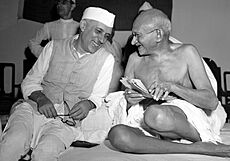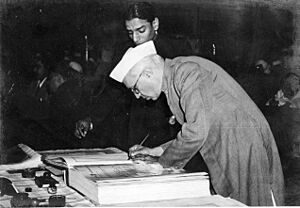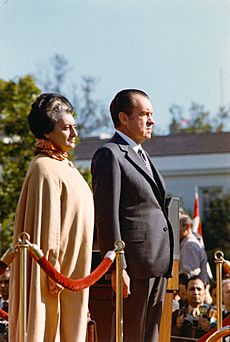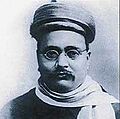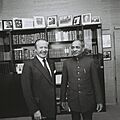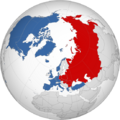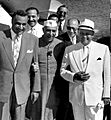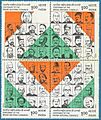Indian National Congress facts for kids
Quick facts for kids
Indian National Congress
|
|
|---|---|
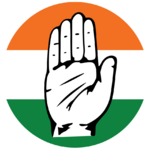 |
|
| Abbreviation | INC |
| President | Mallikarjun Kharge |
| Parliamentary Chairperson | Sonia Gandhi |
| Lok Sabha leader | Rahul Gandhi (LoP in Lok Sabha) |
| Rajya Sabha leader | Mallikarjun Kharge (LoP in Rajya Sabha) |
| Founder | Allan Octavian Hume Womesh Chunder Bonnerjee Surendranath Banerjee Monomohun Ghose William Wedderburn Dadabhai Naoroji Badruddin Tyabji Pherozeshah Mehta Dinshaw Edulji Wacha Mahadev Govind Ranade |
| Founded | 28 December 1885 |
| Headquarters | Indira Bhawan, 9-A, Kotla Marg, New Delhi-110001 |
| Newspaper | Congress Sandesh National Herald |
| Student wing | National Students' Union of India |
| Youth wing | Indian Youth Congress |
| Women's wing | All India Mahila Congress |
| Labour wing | Indian National Trade Union Congress |
| Peasant's wing | Kisan and Khet Mazdoor Congress |
| Membership | |
| Ideology |
|
| Political position | Centre |
| International affiliation | Progressive Alliance Socialist International |
| Colours | Saffron, white and green (official; Indian national colours) Sky blue (customary) |
| ECI Status | National Party |
| Alliance |
Former Alliances
|
| Seats in Lok Sabha |
101 / 543
(542 MPs and 1 vacant) |
| Seats in Rajya Sabha |
27 / 245
(237 MPs and 8 vacant) |
| Seats in State Legislative Assemblies |
653 / 4,126
(4030 MLAs and 5 vacant) (see complete list) |
| Seats in State Legislative Councils |
63 / 426
(390 MLCs and 36 vacant) (see complete list) |
| Number of states and union territories in government |
6 / 31
(28 States and 3 UTs) |
| Election symbol | |
 |
|
| Party flag | |
 |
|
The Indian National Congress (INC), often called the Congress Party or just Congress, is one of the oldest and most important political parties in India. It was founded on December 28, 1885, when India was still under British rule.
At first, the party worked to get more rights for Indians within the British Empire. But later, under the leadership of Mahatma Gandhi, it became the main force in the Indian independence movement. The Congress Party led India to freedom from the United Kingdom in 1947.
After independence, Congress became the most powerful party in India for many decades. It has had six prime ministers, starting with Jawaharlal Nehru. The party is known for being a "big tent" party, which means it includes people with many different ideas. It generally supports secularism (the idea that religion should be separate from government) and social programs to help people.
Contents
History
How the Party Began
In the late 1800s, a retired British official named Allan Octavian Hume wanted to create a group to represent Indian interests. He believed that educated Indians should have a bigger role in the government.
With the help of Indian leaders, the first meeting of the Indian National Congress was held in Bombay (now Mumbai) in 1885. Seventy-two delegates from all over India attended. They were mostly lawyers and educated men. Womesh Chunder Bonnerjee was the first president.
In its early years, the party was moderate. Its members wanted reforms and more jobs for Indians in the government, but they did not demand full independence from Britain.
Two Different Groups

By the early 1900s, the party had split into two main groups:
- The Moderates, led by leaders like Gopal Krishna Gokhale, believed in peaceful talks and working with the British to bring change.
- The Extremists, led by Bal Gangadhar Tilak, wanted more direct action to achieve self-rule, or Swaraj. They were not against the British, but they wanted to push harder for India's freedom.
This division led to a split in the party in 1907, but they later reunited in 1916. Around this time, leaders like Annie Besant and Tilak started the Home Rule movement, asking for self-government for India, similar to what Ireland had.
Gandhi and the Fight for Freedom
When Mahatma Gandhi returned to India from South Africa in 1915, he changed the Congress party forever. He introduced the idea of Satyagraha, which means non-violent protest or civil disobedience.
Gandhi turned the Congress into a mass movement that included people from all walks of life—rich and poor, Hindus and Muslims, and people from every region. Millions of Indians joined protests like the Quit India Movement, demanding that the British leave India.
Under the leadership of Jawaharlal Nehru, the Congress declared its goal of Purna Swaraj (complete independence) in 1929. After many years of struggle and protests, India finally became independent on August 15, 1947.
After Independence
After India gained freedom, the Indian National Congress became the country's main political party. It won the first general election in 1952 and ruled India for most of the next 50 years.
The Nehru Era (1947–1964)
Jawaharlal Nehru was India's first prime minister. He led the country for 17 years. During his time, he focused on building a modern, industrial, and secular nation.
Nehru's government started major projects like building steel plants and dams. He also created a "mixed economy," where both government-owned companies and private businesses could exist. In foreign policy, Nehru followed a path of non-alignment, meaning India did not officially side with either the USA or the Soviet Union during the Cold War.
The Indira Gandhi Era (1966–1984)
After Nehru's death and a short term by Lal Bahadur Shastri, Nehru's daughter, Indira Gandhi, became prime minister. She was a strong and sometimes controversial leader.
In 1969, the Congress party split. Indira Gandhi's faction, called Congress (R), became the most powerful. She led the country to victory in the 1971 war against Pakistan, which led to the creation of Bangladesh.
However, in 1975, she declared a State of Emergency, a period when civil liberties were suspended. This was a very difficult time in India's history. After the Emergency, her party lost the 1977 election.
She returned to power in 1980. In 1984, she ordered a military operation called Operation Blue Star at the Golden Temple in Amritsar. Later that year, she was assassinated by her own bodyguards. This event led to terrible riots against the Sikh community.
Rajiv Gandhi and Economic Changes (1984–1991)
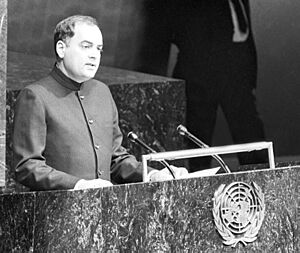
Indira's son, Rajiv Gandhi, became prime minister after her death. He won a huge victory in the 1984 election. He focused on modernizing India's economy and technology.
His government faced some challenges, and he lost the 1989 election. In 1991, while campaigning for another election, Rajiv Gandhi was assassinated.
After his death, P. V. Narasimha Rao became prime minister. He is known for starting major economic reforms in 1991. These changes opened up India's economy to the world and led to faster growth.
Sonia Gandhi and Manmohan Singh (1998–2014)
In 1998, Rajiv Gandhi's widow, Sonia Gandhi, became the president of the Congress party. She led the party for a record 19 years.
In 2004, the Congress-led United Progressive Alliance (UPA) won the election. Sonia Gandhi chose not to become prime minister and instead appointed Manmohan Singh, a respected economist.
The UPA government ruled for ten years (2004–2014). During this time, it passed important laws like the Right to Information Act and the National Rural Employment Guarantee Act (MGNREGA), which promised jobs to the rural poor.
Recent Years (2014–Present)
In the 2014 and 2019 general elections, the Congress party did not perform well, and the Bharatiya Janata Party (BJP) came to power. Rahul Gandhi, son of Sonia and Rajiv Gandhi, served as party president from 2017 to 2019.
After the 2019 election, Sonia Gandhi returned as the interim president. In 2022, Mallikarjun Kharge was elected as the new party president, becoming the first non-Gandhi family member to lead the party in over 20 years.
In the 2024 general election, the party performed better than expected, winning 99 seats. This made it the official opposition party in the Lok Sabha (the lower house of Parliament).
What the Party Believes In
The Congress party's ideas are generally considered to be in the center of the political spectrum.
- Social Policies: The party supports secularism, which means it believes that the government should treat all religions equally. It also supports programs to help the poor and ensure everyone has equal opportunities.
- Economic Policies: For a long time, Congress supported a socialist-style economy with a large public sector. Since the 1990s, it has moved towards a mixed economy, supporting both government and private businesses.
- Foreign Policy: Congress has traditionally supported a policy of non-alignment, building friendly relationships with countries around the world without joining formal military alliances.
Party Structure
The Congress party has a large organization that reaches from the national level down to local districts.
- The All India Congress Committee (AICC) is the main decision-making body.
- The Congress Working Committee (CWC) is a smaller group of senior leaders.
- The party also has wings for different groups, like the National Students' Union of India (for students) and the Indian Youth Congress (for young people).
The party's election symbol is a right hand with the palm facing forward, which represents strength and unity.
Images for kids
-
Abul Kalam Azad, Sardar Patel, and Mahatma Gandhi at a meeting in Bombay, 1940.
-
Prime Minister Lal Bahadur Shastri at an event in Allahabad.
-
P. V. Narasimha Rao was the Prime Minister who started major economic reforms in 1991.
-
Pranab Mukherjee served as Finance Minister and later became the President of India.
-
Prime Minister Manmohan Singh at a military parade in 2007.
-
Jawaharlal Nehru (right) with leaders of Yugoslavia and Egypt. They were key figures in the Non-Aligned Movement.
-
A national convention of the National Students' Union of India (NSUI), the party's student wing.
- All India Congress Committee
- Congress Working Committee
- Electoral history of the Indian National Congress
- High command culture
- Indian National Developmental Inclusive Alliance
- List of chief ministers from the Indian National Congress
- List of Indian National Congress breakaway parties
- List of political parties in India
- List of presidents of the Indian National Congress
- List of state presidents of the Indian National Congress
- Nehru–Gandhi family
- Politics of India
- Pradesh Congress Committee
- United Progressive Alliance
See also
 In Spanish: Congreso Nacional Indio para niños
In Spanish: Congreso Nacional Indio para niños



